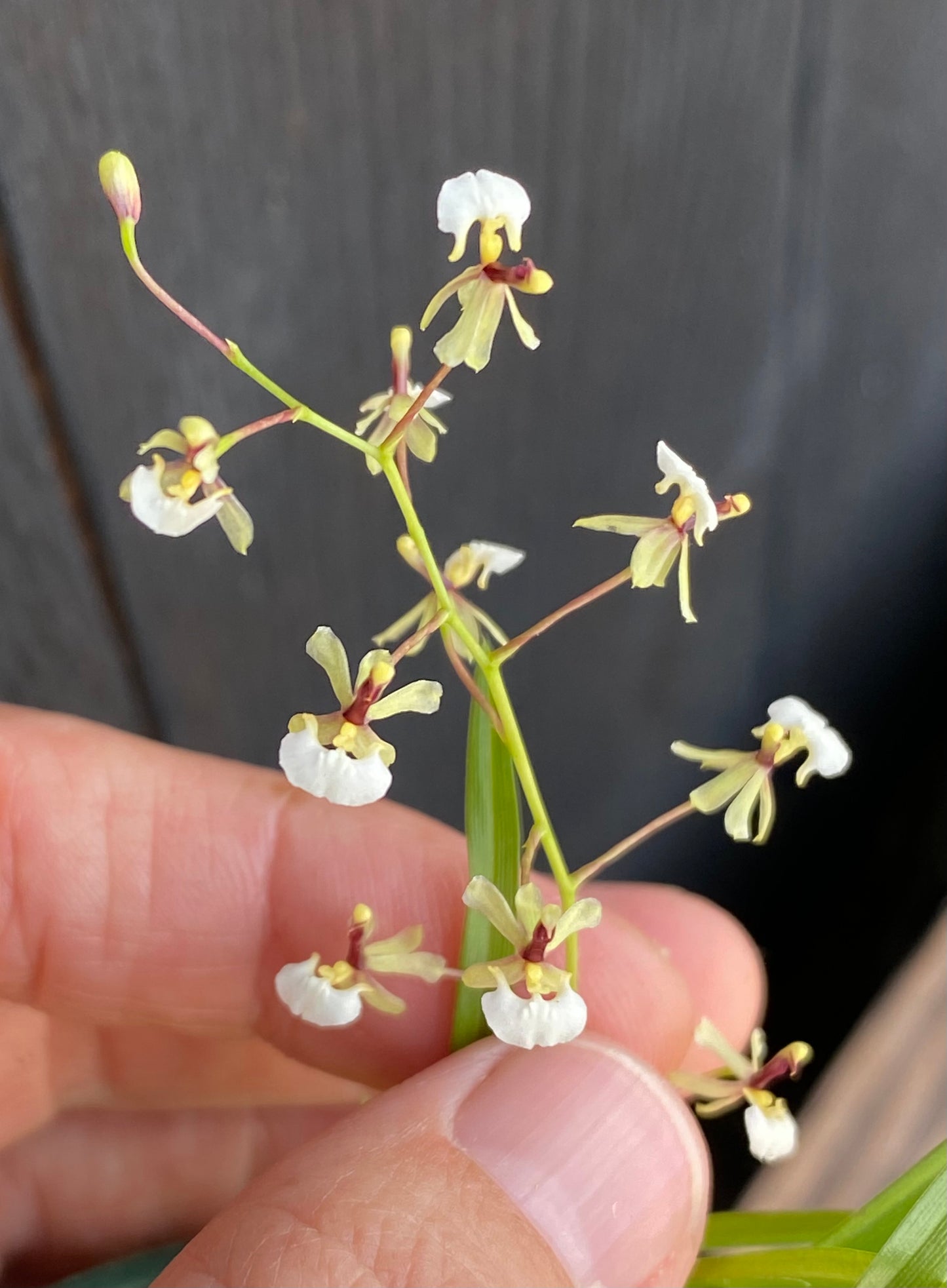Kalapana Orchid Farm
Gomesa radicans
Gomesa radicans
Couldn't load pickup availability
Gomesa radicans (go-MEE-sah RAD-ih-kanz)
This orchid was once famously known as Ornithophora radicans, the "bird-bearing orchid." Peer closely into the center of one of its tiny flowers, and you’ll see it: the column is shaped uncannily like the head and neck of a miniature white bird, beak and all. It’s one of those delightfully nerdy details that makes you appreciate the old-timey botanists. The flowers themselves appear in a cloud-like spray on delicate, arching stems. Each half-inch bloom is a study in crisp contrast, with star-like sepals and petals of a bright lime-green that pull back to feature a spade-shaped, brilliant white lip. A touch of reddish-maroon at the very center anchors the whole affair. The plant is a vigorous rambler, with a creeping rhizome that sends up plump, olive-green pseudobulbs topped with one or two long, thin, almost grass-like leaves. It wants to crawl, forming a dense, attractive mat over time, making it a showstopper when mounted.
Quick Start
Light: Bright shade, 1,500–2,500 foot-candles (≈15k–25k lux). No direct midday sun. Temps: Intermediate to warm. Days 70–80°F (21–27°C); Nights 55–65°F (13–18°C). Water: Water thoroughly, then allow roots to approach dryness. Its rambling habit makes it ideal for mounting, which may require daily watering. Humidity: 60–80% with good air movement. Fertilizer: Weak (¼ strength) balanced fertilizer, weekly during active growth; flush monthly. Media: Best on mounts (cork, tree fern) or in baskets to accommodate its creeping rhizome.
🌺 Orchid Lore & Discovery
Native to the humid Atlantic coastal forests of southeastern Brazil, Gomesa radicans thrives as an epiphyte, scrambling over mossy tree trunks and branches. It's found in a habitat of dappled light and constant moisture, from near sea level up to about 2,600 ft. in elevation. While modern taxonomy has placed it in the genus Gomesa, many growers still fondly refer to it by its former, more poetic name, Ornithophora. The species name, radicans, is Latin for "rooting," a spot-on description of its life strategy: to send out roots all along its rhizome as it creeps across the bark, colonizing its little patch of the forest. This same trait is what makes it such a rewarding plant to grow on a mount, where you can watch it do what it does best.
🌿 How to Grow Gomesa radicans
Light Provide bright but filtered light, similar to what a Cattleya would enjoy. An east-facing window or shaded greenhouse location is ideal. The long, grass-like leaves should be a healthy olive-green. If they become dark green, it needs more light; if they yellow, the light is too direct and intense.
Temperature This is a fairly adaptable species that thrives in intermediate to warm conditions. Aim for daytime temperatures between 70–80°F, with a nighttime drop into the 55–65°F range. Consistent temperatures without extreme fluctuations will produce the best growth.
Water The key to watering Gomesa radicans is to provide ample moisture and then allow the roots to dry quickly. Due to its creeping habit, it is most often grown mounted. Mounted plants may need daily misting or watering during the summer and slightly less in the winter. The small pseudobulbs offer limited water storage, so avoid letting the plant go bone-dry for long periods.
Humidity A humid environment of 60–80% is preferred. If growing indoors in a dry climate, using a humidifier or placing the plant on a humidity tray can be very beneficial. Air movement is crucial to prevent rot in high-humidity conditions.
Fertilizer Feed "weakly, weekly" during periods of active growth. Use a balanced orchid fertilizer diluted to ¼ of the recommended strength. Once a month, flush the mount or pot thoroughly with plain water to wash away any accumulated mineral salts.
Media Mounting is the ideal way to cultivate this orchid. A slab of cork bark, a tree fern plaque, or a piece of hardwood allows the plant's rhizome to wander freely. A small pad of sphagnum moss can be placed under the initial plant to help it establish. It can also be grown in a shallow basket with a very open, fast-draining medium like coarse bark chunks and charcoal, but be prepared for it to crawl over the sides.
Repotting A mounted plant will not need repotting unless the mount itself starts to break down. For basket-grown plants, repot every two years or so, or when the media has decomposed. The best time for this is just as new roots begin to appear from the newest pseudobulbs.
Share










